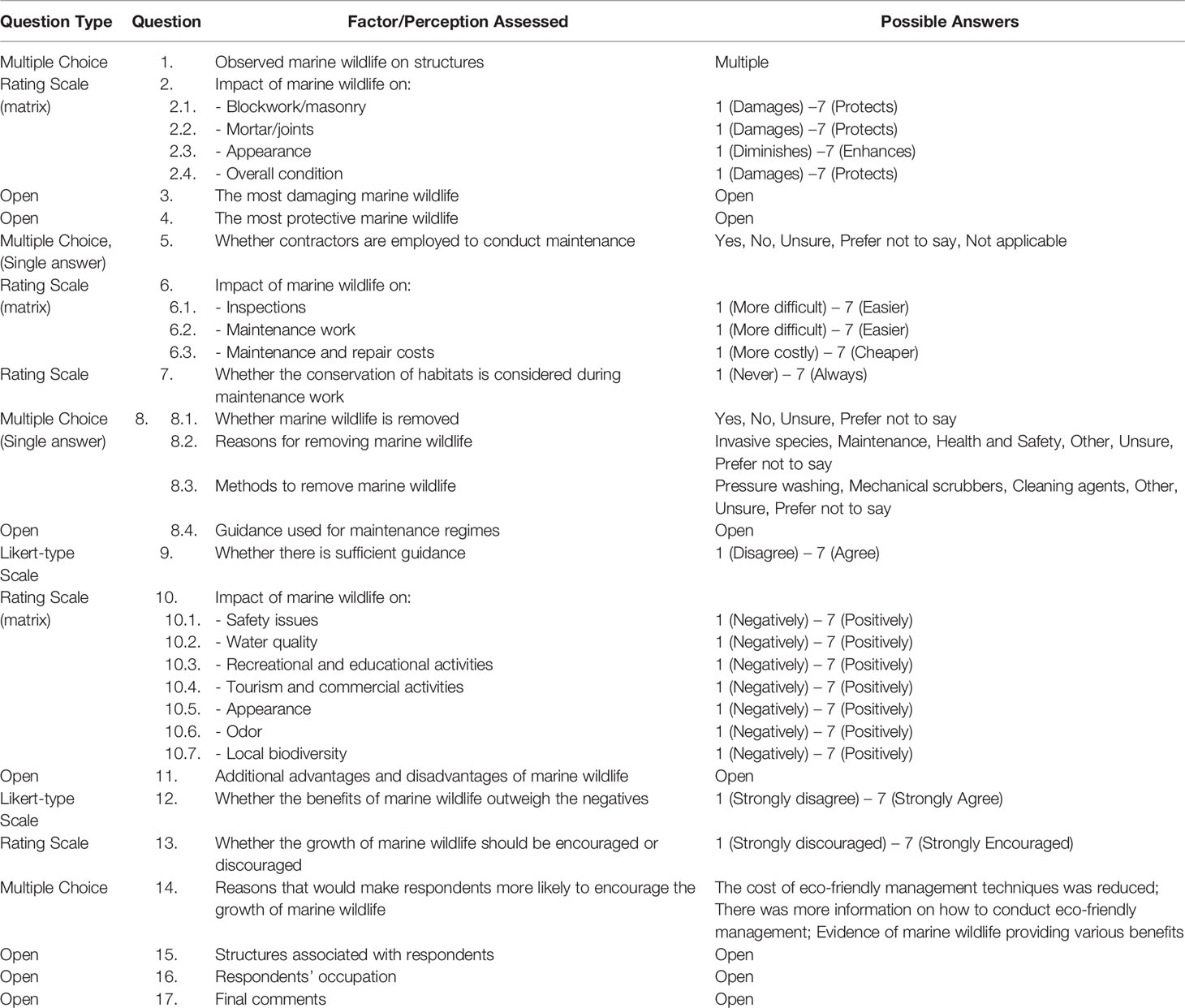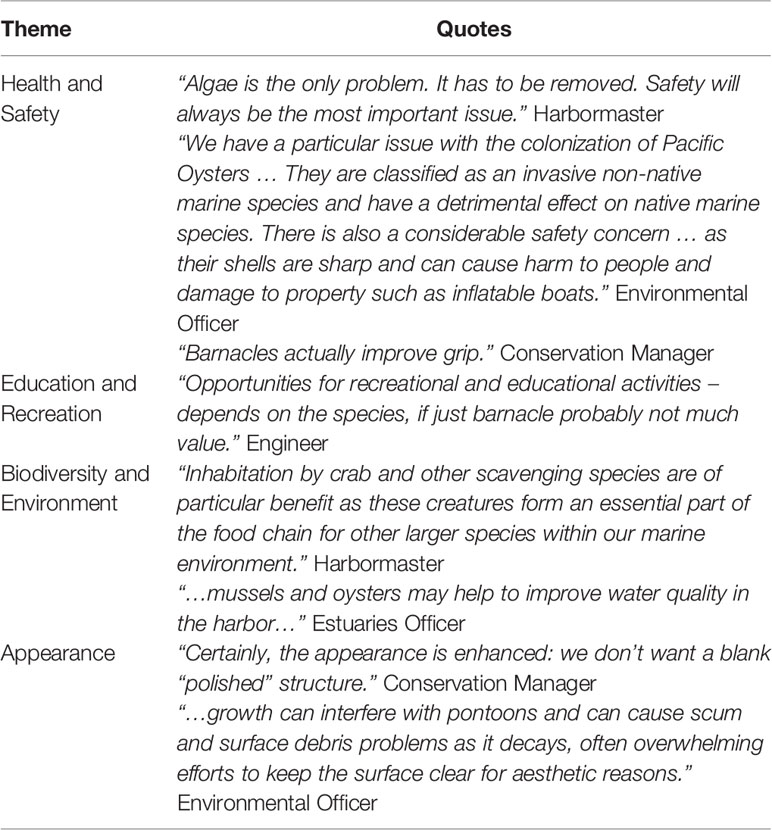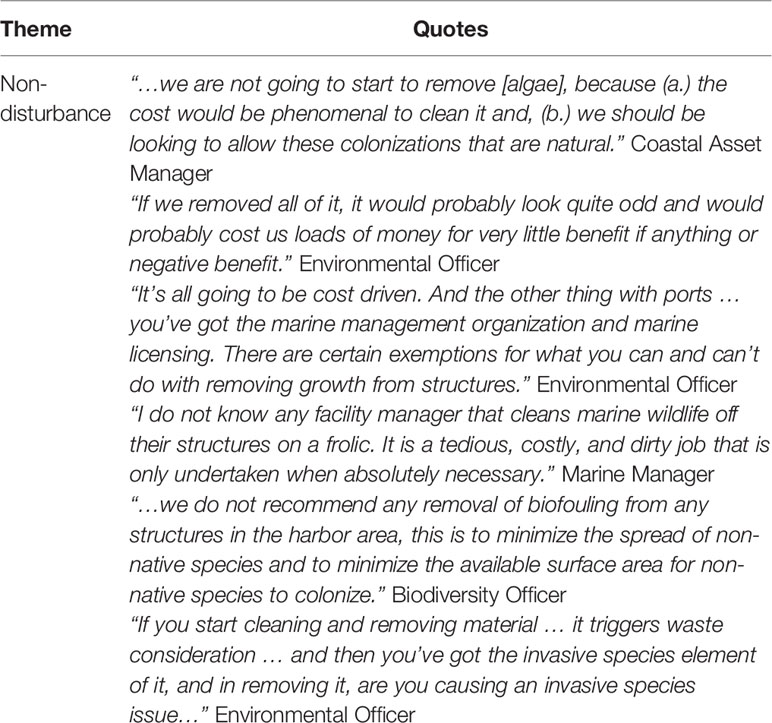- Oxford Resilient Buildings and Landscapes Lab (OxRBL), School of Geography and the Environment, University of Oxford, Oxford, United Kingdom
Maritime built heritage (e.g., historic harbors, breakwaters, etc.) is found widely along the coastlines of Europe. Due to its age and traditional construction, built heritage may represent important and largely unidentified hotspots of biodiversity in marine and coastal environments. At the same time, marine growth (e.g., seaweed, mussels, barnacles, etc.) found on these structures may provide both deteriorative and protective functions. To ensure future research focusing on the two-way interactions between marine growth and built heritage addresses the concerns of those responsible for their management, attitudes towards the colonization and growth of marine wildlife must first be evaluated. Such attitudes will shape how marine growth is managed at these sites, which in turn may influence biodiversity and built heritage conservation and any associated values. This study assesses how the growth of sessile species and other surface-colonizing organisms is currently perceived and managed by those responsible for maintaining maritime built heritage, with a particular focus on historic structures constructed of natural stone. Responses from a semi-quantitative online questionnaire of harbormasters, coastal engineers, environmental officers, and heritage managers from around the UK (n = 132) were analyzed alongside a series of semi-structured interviews (n = 29). Our results demonstrate that attitudes towards marine growth are generally in agreement among practitioners irrespective of their occupation or the historic maritime structures they are responsible for managing. Perceptions of marine growth are mostly positive, but concerns exist regarding its impacts on maintenance regimes, the condition of mortar, and health and safety. As well as highlighting opportunities for a more integrated approach to biodiversity and built heritage conservation, the concerns identified require further research attention to help address potential barriers and conflicts that may arise in practice.
1 Introduction
Historic maritime structures including harbors, quays, and breakwaters, provide essential functions to coastal communities (e.g., access to the sea for maritime activities, flood defence, tourism, etc.). In the United Kingdom, many of these structures are valued as heritage assets and are protected through designations as listed buildings or Scheduled Monuments (Fulford et al., 1997). The age, traditional construction, historic value, and location of these structures within dynamic coastal environments mean they often require careful management (Wyatt and Prizeman, 2018). One component of managing these sites involves the growth of marine wildlife, including epilithic marine algae and benthic organisms such as barnacles and limpets, which often colonize the surfaces of these structures. Where still in use, responsible authorities (e.g., harbor authorities, marine facilities, and the Environment Agency) are required to manage marine growth to ensure structures remain safe and operational (e.g., The Port Marine Safety Code1, The National Flood and Coastal Erosion Risk Management Strategy2), and to meet obligations that promote and protect biodiversity and a healthy marine environment (e.g., The Natural Environment and Rural Communities Act 20063).
Research concerning the interactions between maritime structures and colonizing wildlife has tended to focus on (1) the impacts of structures and associated maintenance regimes on marine ecosystems (e.g., Moschella et al., 2005; Airoldi and Bulleri, 2011; Firth et al., 2016; Sherrard et al., 2016), (2) the impacts of marine wildlife on the deterioration of engineering materials used in maritime structures, such as natural stone and concrete (e.g., Mottershead et al., 2003; Coombes et al., 2013; Lv et al., 2015; Coombes et al., 2017; Chlayon et al., 2018), and (3) techniques for encouraging the colonization of marine wildlife on the surfaces of structures as a way of improving local marine biodiversity, termed ‘ecological enhancement’ (Firth et al., 2016; Strain et al., 2018; O’Shaughnessy et al., 2019). As of yet, however, there is limited understanding of how marine growth is perceived by those responsible for managing these sites, and whether colonization by marine wildlife (i.e., sessile organisms) is viewed positively or negatively by practitioners. Perception studies have previously been used to understand the opinions and priorities of stakeholders involved in the management of maritime infrastructure in order to guide future research into the development of strategies for implementing multi-functional coastal defences (Evans et al., 2017). An improved understanding of attitudes towards marine growth is essential to ensure that future research focusing on the two-way interactions between marine organisms and maritime structures, including those with heritage value, addresses the concerns of those responsible for their management. Such attitudes may shape maintenance regimes that directly influence the marine wildlife these structures support alongside conservation measures and any associated values. For example, the willingness of harbormasters to implement eco-enhancement techniques (e.g., retrofitting artificial rockpools to existing walls) or environmentally friendly management practices aimed at encouraging marine colonization, may, to some extent, be influenced by how they perceive marine growth and its associated impacts. This includes the impact of marine growth on factors relating to the specific responsibilities of managers, such as health and safety, but also other services and values associated with maritime structures and the ecological communities they support (e.g., aesthetic, educational, recreational, etc.).
To address this research gap, we carried out a perception study with more than 130 practitioners involved in the conservation and management of historic maritime structures and marine wildlife in the UK using an online, semi-quantitative questionnaire and a series of semi-structured interviews. As part of a larger project exploring the interrelationships between marine wildlife and historic maritime structures, we designed this study to gain an insight into three areas: first, the perceived impacts of marine growth on the conservation and management of historic maritime structures; second, the perceived advantages and disadvantages of marine growth beyond any supposed impact on the condition of structures; and third, current practices used to remove, manage, and conserve colonizing organisms, and the perceived barriers to the effective implementation of these techniques. By focusing on these three areas, we aimed to identify the dominant perceptions and practices among the respondents as well as any areas of disagreement. We also sought to identify perceived gaps in research, evidence, and advice relating to the management of marine growth on historic maritime structures. The findings from our questionnaire provide the first overview of the attitudes and practices of the target group, whilst our interviews provide valuable context to help situate potentially differing perspectives.
2 Methods
2.1 Questionnaire
The online questionnaire was designed to maximize engagement among appropriate respondents (Toepoel and Dillman, 2012). Initially, a pilot questionnaire was tested on a group of 20 people to check several design aspects (e.g., language clarity, question format and order). The questionnaire was then modified according to recommendations provided in the feedback (Parfitt, 2005; Toepoel, 2016). Before respondents were asked to participate they were provided with precursory information about the questionnaire, including its broad aims and approximately how long it would take to complete. In order to focus their answers, respondents were also asked to consider “historic blockwork or masonry maritime structures … built pre-1960 that are regularly submerged and exposed by the tide” when responding to the questionnaire.
The final questionnaire contained 17 questions. This included an introductory question that was intended to increase interest and encourage respondents to consider different types of marine wildlife found growing on artificial structures when responding to later questions. As the sole purpose of this question was to encourage engagement and to set the scene, responses to this question were not analyzed. The remaining 16 questions were associated with one of four broad themes: (1) five questions on the impacts of marine growth on the conservation and management of historic maritime structures, (2) three questions on the additional advantages and disadvantages associated with marine growth on historic maritime structures, (3) five questions on current practices used to manage and conserve colonizing organisms and any associated barriers, and (4) three questions used to collect attribute data (e.g., occupation) and any final comments (Table 1). Four types of questions were used in the questionnaire:
● Rating Scale - Pairs of antonyms (e.g., negatively – positively, encouraged – discouraged) were placed at the left and right ends of a bipolar scale that ranged from 1 to 7. These questions were presented as standalones or within a matrix when consecutive questions had the same response options.
● Likert-type Scale - Respondents were asked how much they agreed or disagreed with a single statement. The horizontal scale ranged from 1 (strongly disagree) to 7 (strongly agree) with 4 as neutral (neither agree nor disagree).
● Open-ended questions.
● Multiple Choice - Respondents were asked to select one or more options from a list of answers depending on the question. Where deemed appropriate, an “other” answer option and comment field were provided.
The design of the scalar questions was carefully considered to reduce the chance of inconsistent answering behavior and measurement error (Toepoel, 2016). This included using a seven-point scale rather than a five-point scale, providing numbers for every option on the scale (1 to 7), and not using negative numbers or color (De Beuckelaer et al., 2012; Toepoel and Dillman, 2012).
Attribute data collected during the questionnaire included the occupation of respondents and the names of structures they were responsible for managing. Additional information about the structures including age, material, location, heritage designation, and structure type was determined from analyzing publicly accessible databases including the National Heritage List for England4, Canmore5 (the national record of the historic environment in Scotland), and Cof Cymru6 (an online record of Designated Historic Assets in Wales). To aid analysis, data for each of these attributes was categorized into logical groups. For instance, structure location was categorized according to country (i.e., England, Scotland, Wales, or Northern Ireland), and structure age was categorized according to Cultural Periods defined by Historic England. Occupation was differentiated into five groups according to the primary responsibilities of respondents: (1) Harbormasters and Managers (i.e., harbormasters, managers, trustees, and chairpersons), (2) Engineers (i.e., coastal and/or structural engineers, asset managers, etc.), (3) Environmental/Biodiversity Officers, (4) Heritage/Conservation Managers (i.e., National Trust managers, archaeological officers or advisors, etc.), and (5) Other (i.e., any other interested party).
Appropriate questionnaire respondents were recruited using a targeted sampling method. Respondents were identified through email addresses listed on online directories (e.g., the South West Regional Ports Association Directory) and the websites of councils, port associations, harbor authorities, engineering companies, and heritage organizations. Overall, 270 individuals, companies and organizations were directly contacted with personalized emails and invited to respond to the questionnaire. In addition, over 40 coastal partnerships and professional bodies were contacted and asked to disseminate the questionnaire among their members. Of these, 27 responded and shared the questionnaire, including the UK Harbour Masters’ Association (UKHMA).
The questionnaire was hosted by JISC Online Survey (formerly Bristol Online Survey - BOS) and was made available between 4th June 2020 and 2nd February 2021. All respondents were provided with a participant information sheet before agreeing to respond to the questionnaire. Ethical approval for this research, including the questionnaire and interviews, was obtained following standard procedures of the University of Oxford (ethics approval reference number: SOGE1A2020-162).
There were 132 responses to the questionnaire from around the UK (Supplementary Material Appendix 1, Table A1), and on average, it took participants 12 – 15 minutes to complete the questionnaire. At the time of completing the questionnaire, the respondents were responsible for the management and/or maintenance of at least 270 maritime structures, including over 230 harbors, quays, and breakwaters. Of these 270 structures, 16 are registered as Scheduled Monuments and 150 are listed buildings.
2.1.1 Questionnaire Data Analysis
The strength of opinions from scalar questions was assessed using Relative Importance Index (RII) analysis. RII is a non-parametric technique for analyzing ordinal data from structured questionnaire responses (Sodangi et al., 2014; Richards et al., 2018). The index ranges from 0 to 3. A high RII value suggests respondents predominantly selected answers towards the extremes of the scale (i.e., 1, 2, 6, or 7), indicating a strong preference/opinion or the importance of a factor. A low RII value, on the other hand, suggests respondents predominantly selected answers within the middle of the scale (i.e., 3, 4, or 5), indicating ambivalence or neutrality.
An agreement index (AI), adapted from Richards et al. (2018), was used to show the overall directionality of responses and to test for the agreement between the opinions of the respondents. The index ranges from -1 to 1. An AI value close to 1 indicates that responses were predominantly on the right-hand side of the scale (e.g., 5, 6, or 7); an AI value close to -1 indicates that responses were predominantly on the left-hand side of the scale (i.e., 3, 2, or 1). An AI value close to 0 indicates that there was low agreement among the respondents. Neutral responses were not included in the calculations of AI values as they showed no preference to either side of the scale (Richards et al., 2018). For each scalar question, responses to the questionnaire were pooled (n = 132). Single values of RII and AI representative of all respondents were then determined. In addition, RII and AI values were calculated and compared between respondents categorized into different groups (e.g., by occupation, location, etc.) so that between-group variability in the responses could be analyzed.
Visual representations were produced in R (R Core Team, 2021) using the ‘ggplot2’ package (Wickham, 2016) to determine the overall responses of the target group and any relationships between responses and attribute data (e.g., occupation). Spearman’s rank correlation coefficients were used to determine the statistical relationship between responses to different scalar questions. This non-parametric test was used because assumptions of normality, assessed using Shapiro-Wilk tests, were not met.
Open-ended questions were analyzed and coded into primary and secondary themes (Table 2) using the NVivo software (Release 1.5.1, QSR International (UK) Limited, Daresbury, Cheshire, UK). Responses were further differentiated for certain open-ended questions depending on the subject of the response. For example, for Question 3 (i.e., ‘What type of marine wildlife do you consider the most damaging?’) responses were differentiated depending on the type of organism mentioned. Organisms with distinct taxonomic classifications that were easily distinguished by respondents (e.g., barnacles) could be differentiated in the analysis to a greater level than those within polyphyletic groups (i.e., organisms grouped together based on similar characteristics rather than a shared common ancestor), such as ‘algae’, which were necessarily treated in the analysis as encompassing a broader range of species (e.g., macro-algae to unicellular micro-organisms). By grouping responses in this way, patterns within the data were easier to identify, and the chance of misrepresenting the types of marine growth the respondents were referring to was minimized.
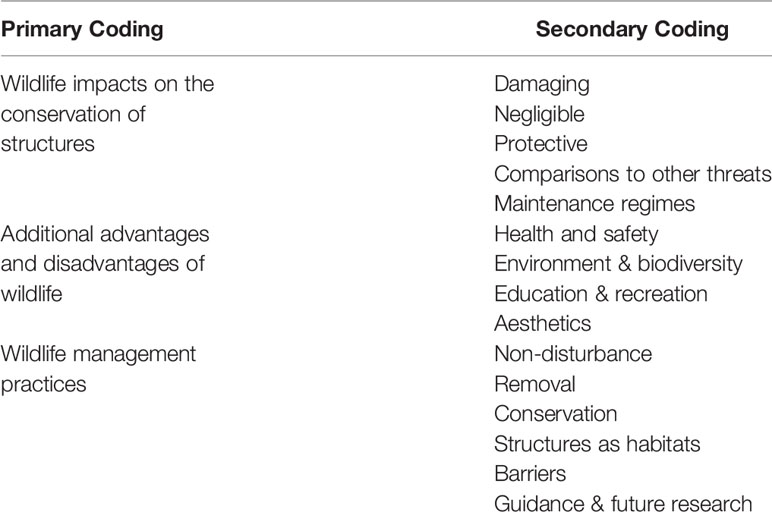
Table 2 List of primary and secondary themes used to code open-ended questionnaire questions and interviews.
2.2 Interviews
Interview participants were primarily recruited through the online questionnaire. Respondents who agreed that they could be contacted at the end of the questionnaire were sent a personalized email inviting them for an interview. One participant who did not want to complete the questionnaire approached us directly to request an interview. All of the interviews were held between June and December 2020, and were conducted remotely via the telephone or online using video communication platforms (e.g., Zoom or Skype). In person, face-to-face interviews were not possible because of travel restrictions imposed by the UK government during national lockdowns in response to the Covid-19 pandemic. During the interviews, participants were invited to expand on themes presented in the questionnaire as well as several new topics including the role of historic maritime structures as habitats for marine wildlife (Table 3). Although the structure of the interviews was prepared in advance, the order (and breadth) of questions varied according to the expertise of the participants (Sesana et al., 2019). With permission from the participants, all of the interviews were audio recorded.
In total, 29 interviews were conducted, with the average interview taking approximately 30 minutes. The interview participants had diverse specialisms related to the management of history maritime structures and marine wildlife (Supplementary Material Appendix 1 and Table A1), and between them, worked with or were responsible for at least 97 historic maritime structures from across the UK.
2.2.1 Interview Data Analysis
The interviews were transcribed, analyzed, and coded using the NVivo software (Release 1.5.1, QSR International (UK) Limited, Daresbury, Cheshire, UK) according to the same primary and secondary themes used to code the open-ended questionnaire questions (Table 2). Illustrative quotes from each theme were then identified to provide context to the views that emerged during the questionnaire and throughout the study.
3 Results
The results are presented based on the primary and secondary themes from the NVivo coding (Table 2). The results are supported by illustrative quotes and the analysis of quantitative data derived from responses to scalar questions in the questionnaire.
3.1 Impacts of Marine Growth on the Condition of Structures
Questionnaire respondents tended to indicate either a neutral or negative perception of the impact of marine growth on the condition of structures (Figure 1, Q2). More than half (55%) considered the effects of marine growth on stonework to be insignificant, although a considerable minority (27%) viewed marine growth as a cause of damage. Most respondents held negative perceptions of the impact of marine growth on the condition of mortar, with 57% suggesting damaging effects. This is further indicated by an AI value close to -1 for Question 2.2 (Figure 1). Interview participants generally perceived the impacts of marine growth on the overall condition of historic maritime structures as “negligible” or minimal (17 out of 29), with several commenting on the “passive” or “benign” nature of marine growth. In general, respondents who worked as environmental officers perceived the impacts of marine growth more positively than harbormasters, engineers, or heritage managers, although the variability in opinions between different groups was relatively small (Figure 2A). Furthermore, responses indicated that the perceived risk of damage to a structure was dependent on the type of structure being considered. For instance, several respondents stressed the susceptibility of wooden and metal structural elements to direct and indirect damage caused by marine growth compared to stonework.
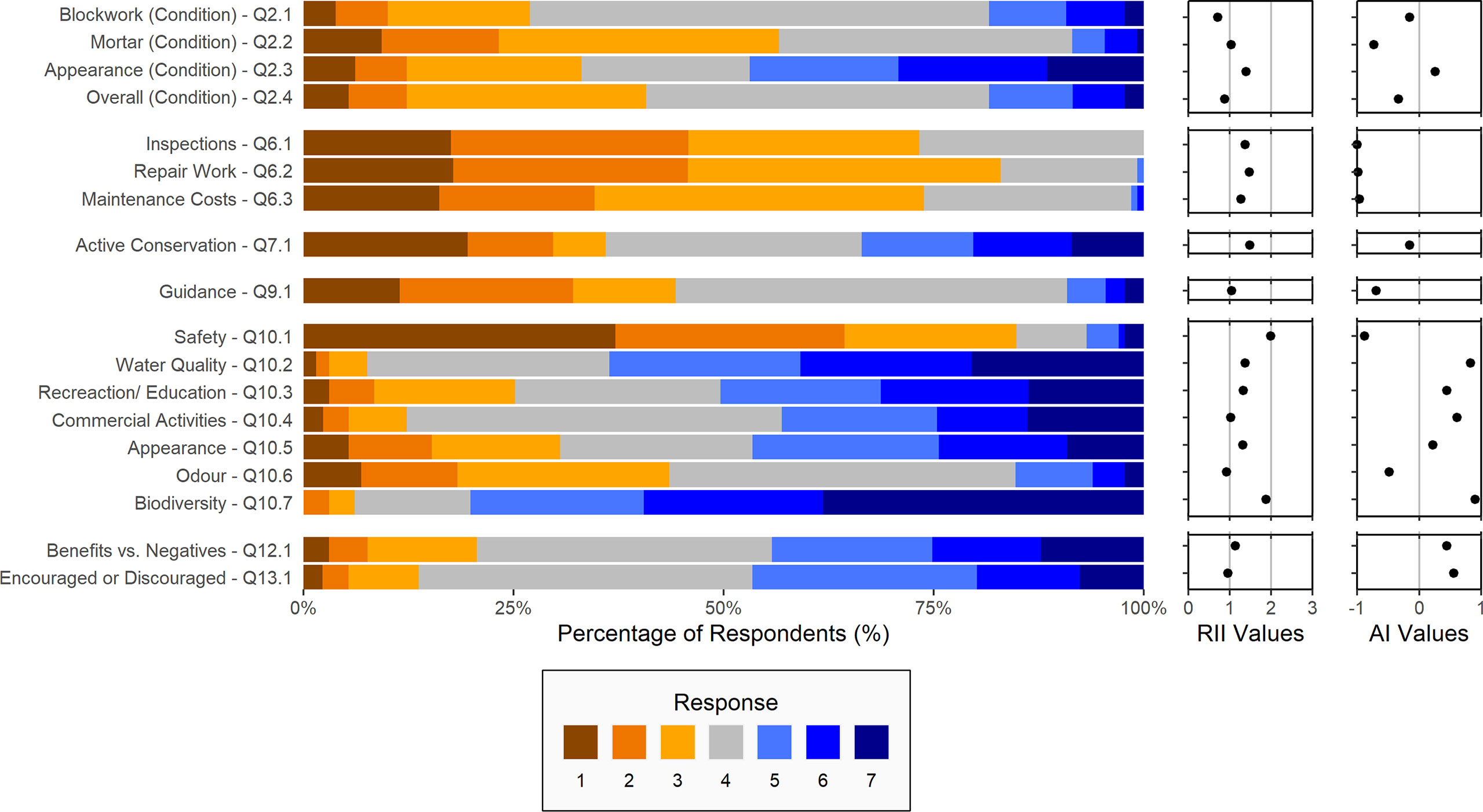
Figure 1 Responses to scalar questions in the questionnaire as a percentage of total respondents with their corresponding RII and AI values. See Table 1 for Question number and description.
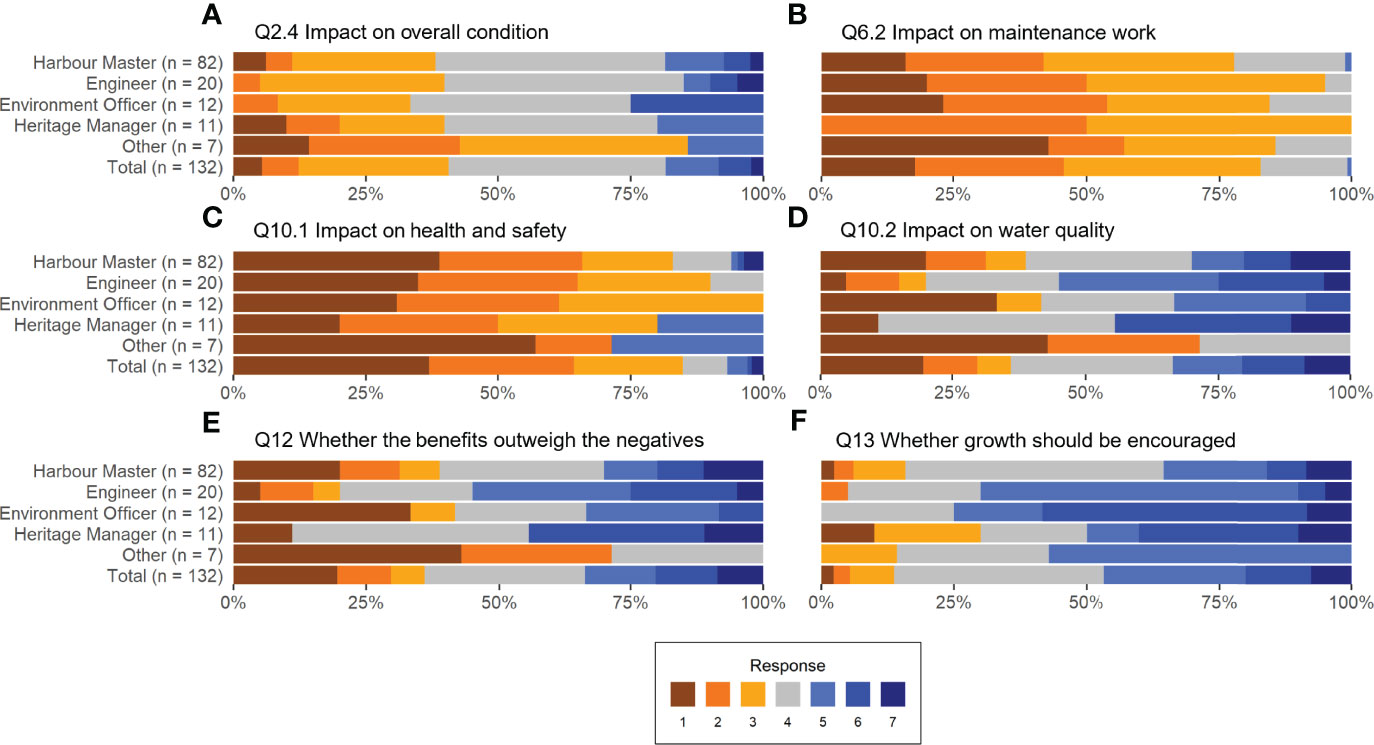
Figure 2 Responses to a selection of scalar questions in the questionnaire differentiated by occupational group. The questions relate to the impact of marine growth on (A) the overall condition of a structure, (B) maintenance work, (C) health and safety, (D) water quality, and whether (E) the benefits of marine growth outweigh the negatives and (F) whether marine growth should be encouraged or discouraged.
3.1.1 Damaging Types of Marine Growth
The type of marine growth that was mentioned the most in relation to damaging affects was marine algae (Figure 3). Questionnaire responses indicated two dominant opinions as to why marine algae were considered damaging (Table 4). Firstly, algae holdfasts were perceived to “root” or penetrate material causing cracks to expand (i.e., active damage). Secondly, algae were perceived to increase the susceptibility of material to being removed during storm events due to their fronds increasing drag on the surfaces they are attached to (i.e., passive damage). Other forms of active biodeterioration mentioned by respondents included damage caused by boring worms in mortar and timber, the rasping of limpets on stone surfaces, and the undermining of structures by burrowing tubeworms (e.g., Ficopomatus enigmaticus). Respondents also commented on the perceived damage caused by passive forms of biodeterioration associated with marine growth, including bio-chemical weathering processes facilitated by the enhanced retention of surface moisture by barnacles, and increases in mechanical strain caused by the build-up of organic matter on structures (i.e., the accumulation of oysters and/or seaweed on harbor walls).
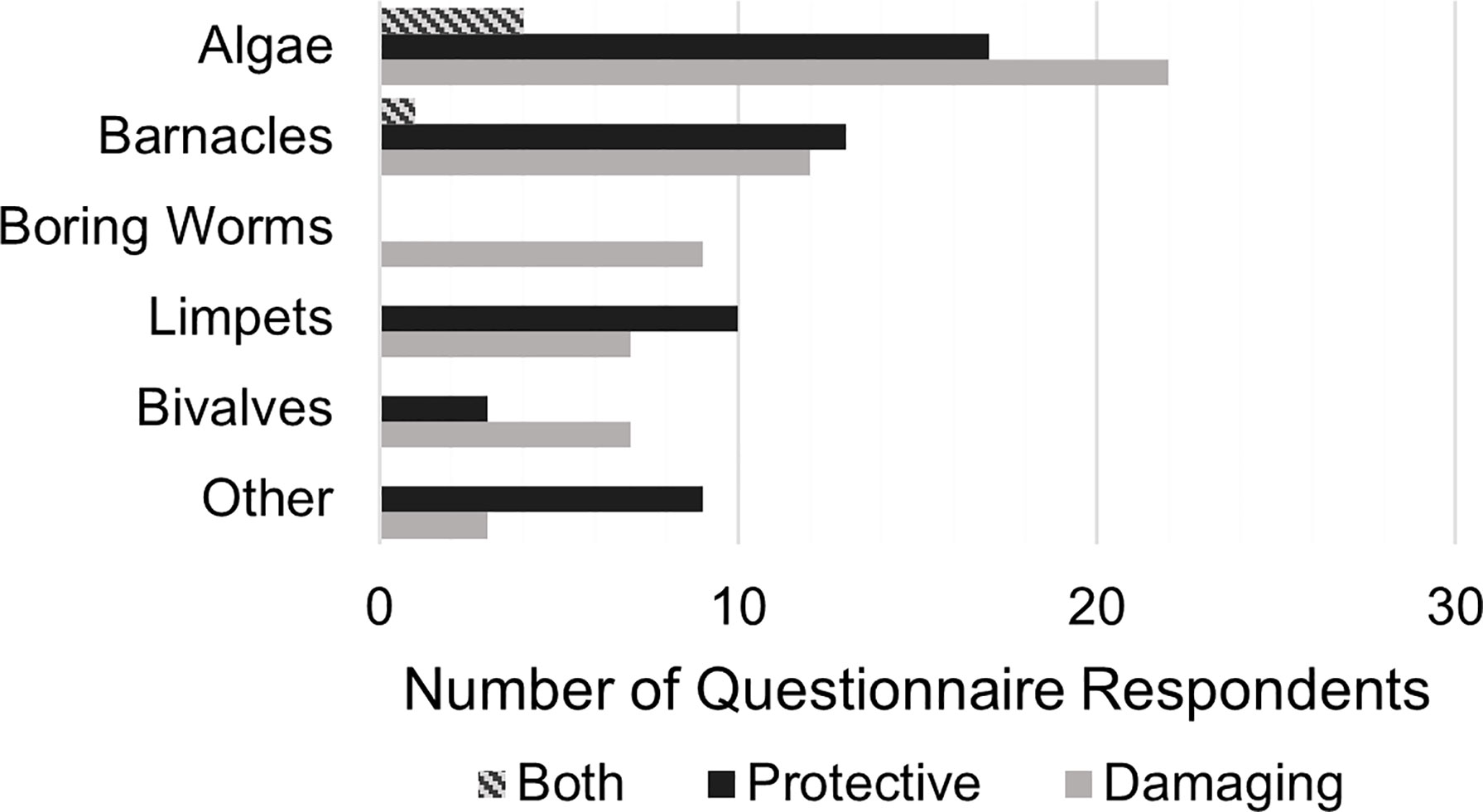
Figure 3 Types of marine wildlife identified by questionnaire respondents as the most damaging and most protective to historic maritime structures.
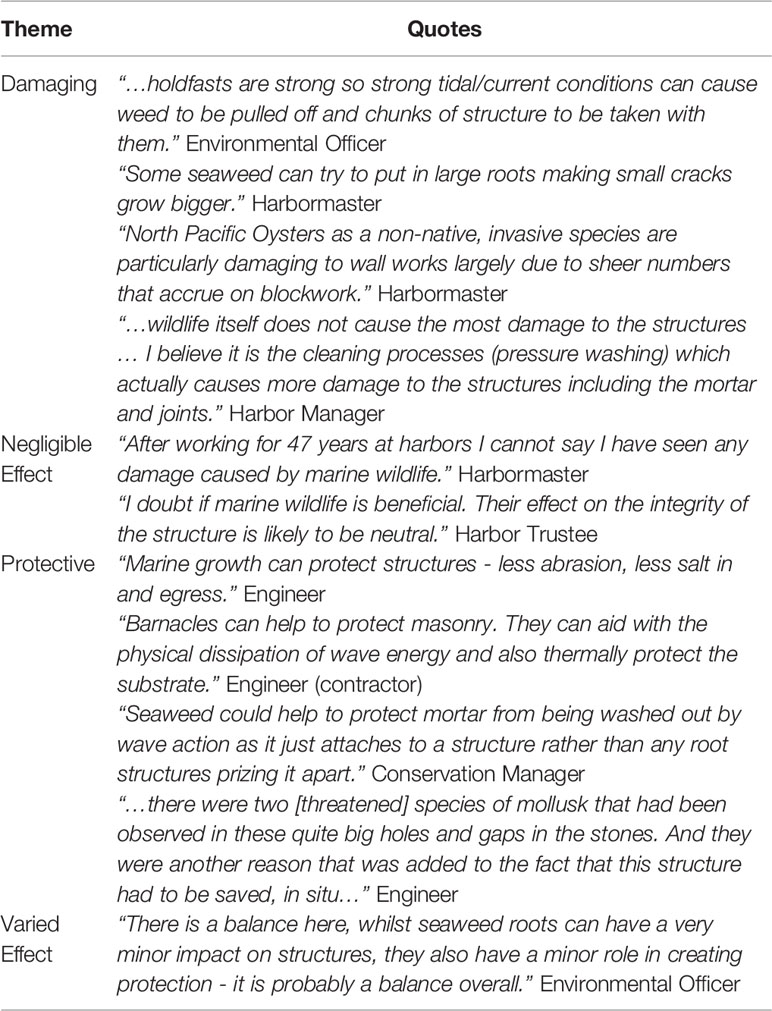
Table 4 Illustrative quotes concerning the perceived impact of marine growth on the condition of historic maritime structures.
Cleaning processes associated with the removal of surface marine growth were identified by several questionnaire respondents and interviewees as a cause of damage. For some, the removal of marine growth through pressure washing, scraping (barnacle removal), pulling (macro-algae removal), and smashing and chiseling (oyster removal) were perceived to be a cause of more damage than the wildlife itself.
3.1.2 Protective Types of Marine Growth
Marine growth was perceived to contribute to the direct and indirect protection of maritime structures in several ways. The most commonly held perception was that canopy forming marine algae and encrusting species reduced the susceptibility of structures to damage from wave action, abrasion, and boat collisions through the provision of a physical barrier (Table 4). For example, respondents commented on how macro-algae (seaweed) protects “…mortar from being washed out by wave action…” and “…improves mechanical impact strength…”, and how barnacles “…break up the wave forces…” and “…aid the physical dissipation of waves”. Several respondents commented on the perceived ability of marine growth, including macro-algae, barnacles, and lichen, to “seal”, “plug”, and “fill” cracks in stonework and mortar, while one respondent emphasized the ability of barnacles to “…bind loose masonry…” preventing it from being dislodged.
Marine growth was also perceived to indirectly protect structures by reducing the efficiency of rock weathering processes and steel corrosion through the regulation of near-surface temperature, moisture, and salt accumulation. For example, one respondent commented that barnacles “…thermally protect the substrate…” onto which they attach. Questionnaire respondents and interviewees also emphasized the unintentional, indirect protection afforded to historic maritime structures through marine species that are protected by UK wildlife legislation (i.e., the Wildlife and Countryside Act 1981). It was suggested that protected species “…help prevent unsympathetic or damaging repair/maintenance to historic structures…” as legislation prohibits the unnecessary disturbance and destruction of their habitats, which in some cases may include the structures themselves.
In addition to being perceived as destructive, marine algae were the type of marine growth most mentioned in relation to its protective properties (Figure 3). Mechanisms of algal attachment that were perceived as damaging by some respondents were, in contrast, perceived by others as non-existent or having limited or no impact. For instance, the perception of one respondent that macro-algae cause damage by attaching through “large roots” contrasts directly with the perception of another respondent who believed that macro-algae only attach to the surfaces of structures. The contrasting viewpoints surrounding the effects of marine algae is highlighted best through four questionnaire respondents who commented on the ability of marine algae to impact both positively and negatively on the condition of a structure.
3.1.3 Comparison to Other Threats
Although not directly asked, comparisons between the impacts of marine growth and other threats posed to historic maritime structures were provided by several questionnaire respondents (Table 5). For these individuals, wave action and weathering processes were often of greater concern than the effects of colonizing wildlife. This view was supported by the interviewees, with more than a third emphasizing that the magnitude of damage caused by natural, weather-driven processes was greater than that caused by marine growth. Collisions from boats, inappropriate maintenance techniques, and the damaging effects of rooting (non-marine) vegetation were also mentioned as significant causes of deterioration by both the questionnaire respondents and interviewees.
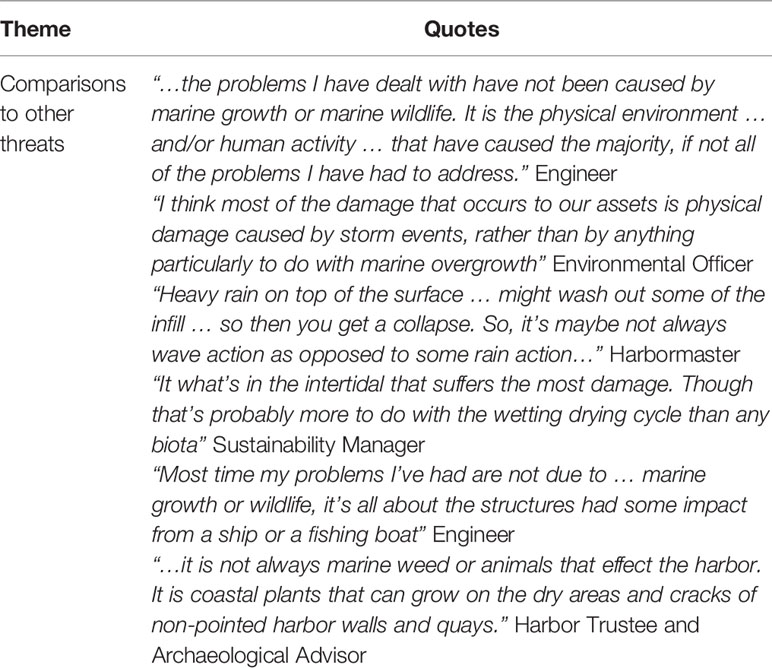
Table 5 Illustrative quotes comparing the impacts of growth wildlife to other natural threats and human activity.
3.2 Impacts of Marine Growth on Maintenance Work
Questionnaire responses collectively indicated that marine growth is perceived to have a negative impact on structural inspections, and the cost and implementation of maintenance work (Figure 1, Q6). This is highlighted by AI values equaling or close to -1 for the three parts of Question 6. The negative perception of marine growth on maintenance work was found to be relatively consistent among subsets of respondents differentiated by location (e.g., England, Scotland, Northern Ireland, and Wales), occupation (e.g., harbormaster, environmental officer, etc.; Figure 2B), and the structures they were responsible for managing (e.g., structure type, age, material, or heritage designation). The perception that marine algae “obscure” or “hide” structural defects from visual inspections and underwater assessments was the issue most mentioned by questionnaire respondents. This view was echoed by several interview participants who were negative about the impact of marine growth on assessments of stonework and mortar in the intertidal zone. While the majority of respondents expressed the view that marine growth negatively impacts maintenance work, the perceived severity of these impacts differed among individuals. For example, some respondents commented on marine growth as “awkward” or a “nuisance” rather than a serious threat to the maintenance of structures. In contrast, several other respondents emphasized the negative impact of marine growth on the restoration of coastal heritage assets, such as scheduled monuments, and the safety and legal implications associated with accidents or structural failures due to inadequate inspections caused by marine growth. The protective properties associated with some marine species viewed in combination with the perceived negative impacts of colonizing wildlife on structural assessments led one interviewee to view marine growth as a “double-edged sword” (Table 6).
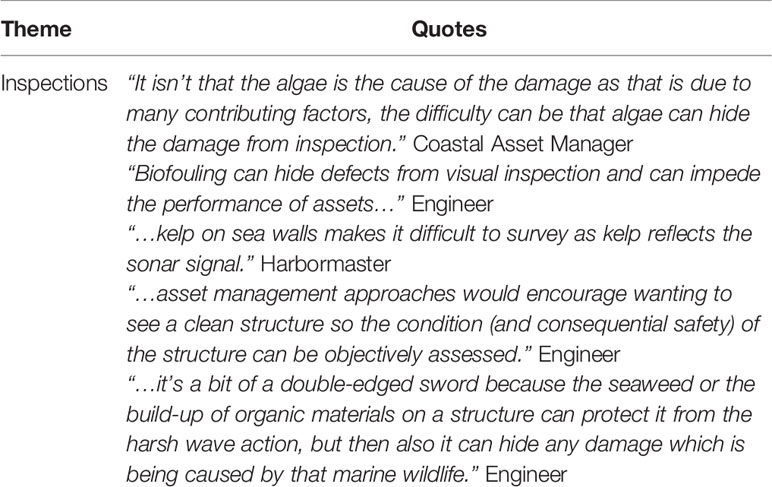
Table 6 Illustrative quotes concerning the perceived impacts of marine growth on maintenance regimes.
3.3 Additional Advantages and Disadvantages Associated With Marine Growth
Responses indicate a shared negative perception towards the impact of marine growth on health and safety (Figure 2C); over 85% of respondents emphasized the negative impacts of marine growth on health and safety compared to 7% who viewed it as having a positive influence (Figure 1, 10.1). The overall strength of this negative perception among respondents is highlighted by an RII value close to 2 for Question 10.1, the highest for any of the scalar questions. Marine algae were most frequently identified as posing a risk to health and safety, followed by invasive Pacific oysters (Magallana gigas) and barnacles. Specifically, respondents commented on the tendency of marine algae to increase the slipperiness of surfaces, reducing safe access (i.e., to stairs, ladders, slipways, etc.) and increasing the risk of accidental slips and falls. The sharp surfaces of barnacles and Pacific oysters were identified as a potential cause of scrapes and cuts, and damage to inflatable craft. In contrast, several interview participants commented on the perceived ability of barnacles to reduce the risk of falls and increase safety by impeding the growth of slippery algae and increasing surface roughness, thereby enhancing overall grip (Table 7).
Marine growth was consistently perceived to positively influence the environment surrounding maritime structures (Figure 2D). There was an overall perception that marine growth enhances local biodiversity and that filter feeders, such as oysters and mussels, provide valuable ecosystem services by regulating and improving the local water quality, as indicated by AI values close to 1 for Questions 10.2 and 10.7 (Figure 1). As well as being a unique component of ecosystems, marine growth was perceived to contribute to biodiversity by supporting and/or attracting other sessile species and mobile organisms by providing shelter (i.e., canopy forming species) and food. The only cases where marine growth was perceived to negatively impact biodiversity related to non-native invasive species, with concerns relating to the impacts of Pacific oysters most frequently mentioned. Marine growth was also identified as providing educational and recreational benefits including “harvesting”, “angling”, and “wildlife tourism”. However, respondents also discussed the “stink” of algae and the negative effects of marine growth and associated “pests” on boat and harbor operations, such as when algae or bird droppings obscure navigation aids or tidal gauges. A shared negative perception of the smell of marine growth is indicated by an AI value below 0 for Question 10.6 (Figure 1).
Responses varied concerning the impact of marine growth on the appearance of structures, with 46% and 31% of respondents holding positive and negative perceptions, respectively. This disagreement among respondents is indicated by an AI value close to 0 for Question 10.5 (Figure 1). Those with positive views commented on the “attractive” aesthetics of colonizing wildlife, and ability of marine growth to hide modern repairs and blend structures into the surrounding landscape. In contrast, a minority of respondents perceived marine growth as “unsightly” or detrimental to the long-term appearance of structures due to bio-deteriorative processes that enhances material decay.
3.4 Reasons and Methods for Removing Marine Growth
Over half of the questionnaire respondents (51%) indicated they did not actively remove marine growth from the structures they are responsible for. Possible motivations for this were discussed by several interview participants and included the perception that removing marine growth was costly, unnecessary in most circumstances, and could cause unintended consequences including the colonization of cleared areas by invasive species or their spread via inappropriate waste management (i.e., disposing of cleared organic material, including invasives, into the sea). Legislative restrictions on the disturbance and removal of marine wildlife imposed by the Marine Management Organisation were also cited as a reason for not actively clearing marine growth, along with the perception that removal should be avoided as colonization was “natural” and should be encouraged instead (Table 8).
Respondents who indicated that they actively removed marine growth suggested that the main reasons for doing so related to concerns about health and safety or non-native and invasive species, or as a necessary requirement to conduct structural inspections (Figure 4A). The removal of “unsightly” or smelly algae was also mentioned as a reason. Reasons for removing marine growth varied among different occupational groups. Engineers, for example, indicated that they predominantly removed surface-colonizing wildlife to allow inspections and maintenance work. Harbormasters, on the other hand, were more likely to remove marine growth due to safety concerns, while environmental officers and heritage managers were the groups most likely to remove wildlife as a response to non-native invasive species. Pressure washing was the most popular method for removing marine growth, although cleaning agents, scrubbers, and hand-tools are also used (Figure 4B).

Figure 4 (A) Reasons for respondents actively removing marine wildlife from the structures they manage differentiated by species type/hazard, and (B) methods used by respondents to remove marine wildlife.
3.5 Biodiversity Conservation
The majority of respondents (61%) indicated they were involved in the conservation of marine wildlife, yet degrees of engagement varied among individuals. Respondents suggested they used both passive and active conservation methods to enhance biodiversity. Passive conservation methods mentioned by respondents include the conscious, non-disturbance of marine growth and habitats during inspections and maintenance work (Table 9). This includes leaving weathering features that act as unique habitats for marine wildlife, such as crevices that develop over many years of exposure, unrepaired unless necessary to maintain the safety of the structure. Active conservation methods mentioned by respondents include using eco-friendly cleaning products, conducting wildlife surveys, scheduling maintenance work to avoid important phenological events (e.g., breading seasons), tackling invasive species (e.g., culling), and retrofitting structures with ecological enhancements, such as using textured form-liners and artificial rockpools.
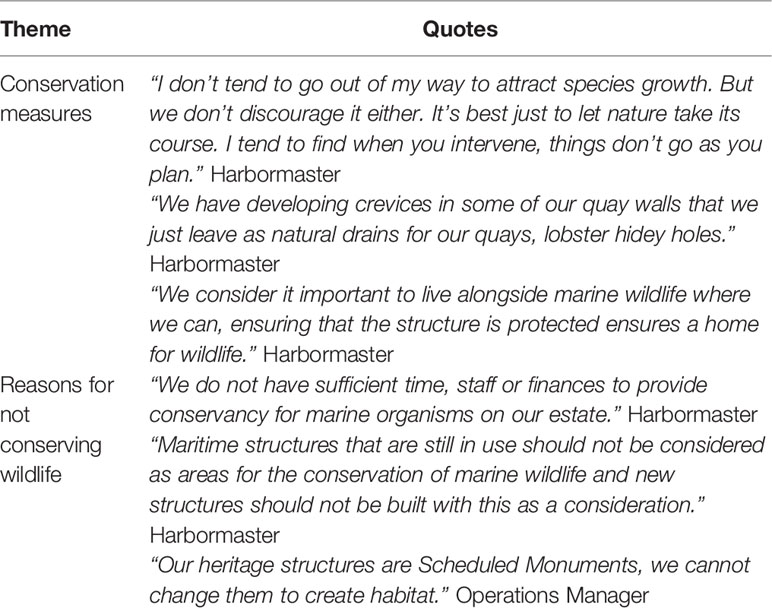
Table 9 Quotes illustrating conservation measures adopted by respondents and the reasons for not adopting conservation measures.
In contrast, 16% of respondents indicated they were not involved in any wildlife conservation. Reasons included the cost of implementation, prioritizing safety, heritage designations that prohibit significant physical modifications to structures aimed at promoting biodiversity (e.g., the installation of eco-enhancements, such as artificial rockpools), and a general perception that wildlife conservation should not be their responsibility. Among some respondents, there was a belief that the conservation of protected structures (i.e., a listed building or scheduled monument) always took precedent over the enhancement of marine biodiversity. For example, one respondent commented that “heritage trumps everything” and there “couldn’t be compromise” between heritage and marine wildlife conservation. In contrast, others were less sure, stating that they did not know what was more important or what they would prioritize. A Spearman’s rank correlation test showed there was a weak but significant correlation between the degree to which respondents considered marine growth beneficial to a structure’s condition (Q2.4) and their involvement in marine wildlife conservation (Q7.1) (ρ(125) = 0.301, p < 0.001).
3.6 Structures as Habitats
Historic maritime structures were viewed as “havens” for marine wildlife by several interviewees, including a harbormaster and an environmental officer (Table 10). Harbors in particular were highlighted for providing habitats for a variety of sessile organisms and mobile species, such as fish, marine mammals (e.g., seals), and crustaceans (e.g., prawns, shrimps, and crabs). Several interviewees commented on how structures provided habitat to species with conservation status, including Honeycomb worms (Sabellaria alveolata), endangered mussel species, and “priority species of algae”. Interviewees also emphasized how historic structures provide nests and feeding grounds for birds, including species of conservation concern such as the ringed plover (Charadrius hiaticula), the purple sandpiper (Calidris maritima), and the kingfisher (Alcedo atthis). In comparison to “modern”, “highly polished”, “flat concrete” structures, historic structures were described as having “surface texture” and “cavities” or “crevices”, which were perceived to encourage the growth and colonization of marine wildlife. Although generally this was seen as a positive, some commented on the possibility of historic structures providing habitats to “invasive nasties” or pests such as pigeons and mink. One interviewee expressed concern about historic structures supporting protected species, suggesting that this could cause tensions to arise between stakeholders invested in the conservation of wildlife and others invested in the maintenance and conservation of heritage assets.
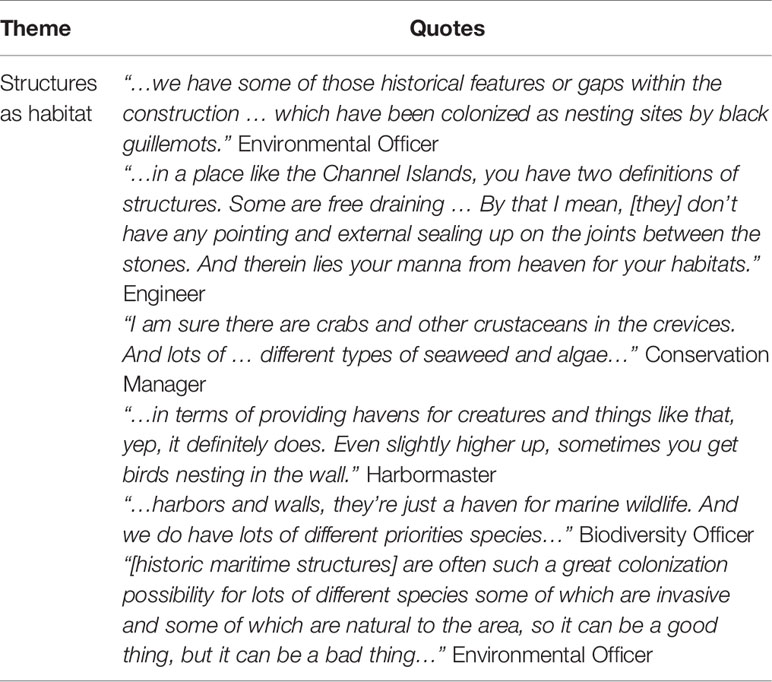
Table 10 Quotes illustrating the perception that historic structures provide habitats for marine wildlife.
3.7 Research and Guidance
Nearly half of respondents (44%) indicated that they believed there was insufficient guidance concerning the management of marine growth on historic maritime structures. Several areas were identified where additional guidance and information supported by research would be welcome. These include (1) the impacts, both positive and negative, of different species on various materials used in the construction and repair of historic maritime structures, (2) the tangible and intangible values people associate with marine growth beyond any perceived impact on the condition of a structure, including how it influences the structure’s aesthetics, (3) ways to encourage and/or discourage different types of biological growth according to material and structure type, (4) clarity on how best to combat the spread of invasive species whilst also promoting biodiversity (i.e., clearing marine growth vs. leaving it undisturbed), (5) advice on effective ecological enhancement techniques, with a particular focus on methods used at historic sites to provide mutual benefits for heritage and marine wildlife, and (6) information on whether heritage assets provide unique habitats for marine wildlife (i.e., sessile species but also mobile organisms) compared to modern structures (Table 11).
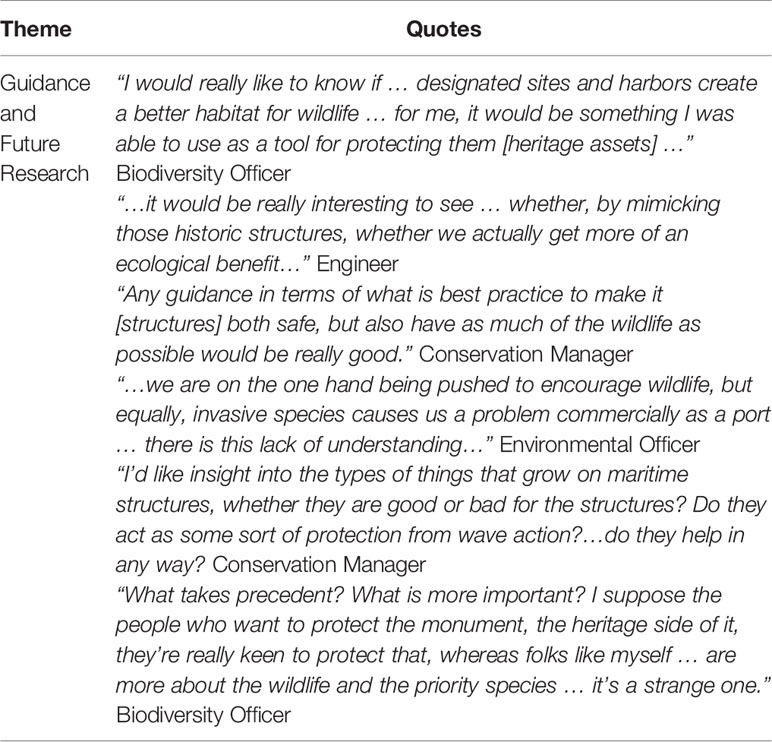
Table 11 Illustrative quotes concerning guidance and research that would be welcomed by respondents.
Within these broad themes, respondents provided specific details of the information and guidance they would find useful. For example, one respondent was interested in understanding whether patterns of colonization could be selectively encouraged to create a safe harbor environment; this respondent wanted to know whether structures could be designed or retrofitted to discourage slippery algae and encourage marine growth with a “grippier finish”. Another respondent indicated that more information should be available on whether design and management decisions primarily aimed at preserving the heritage value of historic structures impacted upon colonizing wildlife. This includes, for example, efforts to maintain the appearance of historic stonework during restoration projects by replacing missing blockwork with pre-weathered stones instead of concrete.
Respondents most frequently identified practical experience and formal information provided by government agencies (e.g., Marine Management Organisation) and non-departmental public bodies (e.g., the Environment Agency and Natural England) as sources of guidance for managing marine growth. However, only a small number of respondents (9%) indicated that current guidance was sufficient in relation to the management of wildlife that grows on maritime built heritage (Figure 1. Q9.1).
3.8 Overall Benefits of Marine Growth
Over 40% of the respondents indicated they believed the benefits of marine growth on historic maritime structures outweighed the negatives. This compares to 21% of respondents who believed the opposite (Figure 1. Q12.1). Nearly half (46%) of the respondents suggested that marine growth should be encouraged on structures, with only 14% indicating it should be actively discouraged. The remaining 40% of the respondents indicated that biological growth should neither be encouraged or discouraged (Figure 1. Q13.1). A general perception among respondents that marine growth is beneficial and should be encouraged is highlighted by AI values between 0 and 1 for Questions 12.1 and 13.1. A weak but significant correlation was found between the degree to which respondents considered marine growth beneficial overall (Q12.1) and attitudes on whether growth should be encouraged or discouraged (Q13.1) (ρ(129) = 0.432, p < 0.001). In general, environmental officers were more likely to believe that the benefits of marine growth outweigh the negatives, and, consequently, encourage rather than discourage marine growth on structures compared to harbormasters, engineers, and heritage managers (Figures 2E, F).
Of the options provided in the questionnaire, evidence of marine growth providing protection to historic maritime structures was most frequently selected by respondents as a reason why they would be more likely to encourage surface-colonizing organisms. This was followed by evidence of marine growth improving water quality and of historic structures acting as unique habitats for marine wildlife (Supplementary Material Appendix 2, Figure A2).
4 Discussion
Practitioner attitudes towards wildlife growing on historic maritime structures were mostly positive and were generally in agreement. Environmental officers often held stronger opinions than engineers, harbormasters, and heritage managers; however, overall, variability between groups was either small or negligible. Perceptions of marine growth were relatively consistent among respondents irrespective of their occupation or the historic maritime structures they were responsible for managing. For instance, the overall directionality of opinions (i.e., positive vs. negative) was consistent among respondents differentiated by occupation for all but one of the questions assessing attitudes towards marine growth (i.e., Q2.1). The variability of opinions between different groups was particularity low for questions relating to the impacts of marine growth on maintenance regimes, health and safety, mortar deterioration, and the overall condition of structures. Such similarities in attitudes may indicate that certain factors, such as occupation and the type of structure managed, do not significantly influence how marine growth is perceived. Furthermore, it may indicate shared interests in finding a balance between wildlife and heritage conservation across a diverse range of marine management practitioners.
The consistent perception among respondents that marine growth negatively impacts upon maintenance work, the condition of mortar, and health and safety, as indicated by AI scores equal or close to -1, supports the notion that these impacts are experienced by practitioners from across the UK. Agreement among respondents and the strength of these perceptions may, in part, be due to the consequences associated with the mismanagement of these factors. For example, anything that is perceived to reduce safety is likely to evoke a strong response from managers given that the consequences of negligence include injury, loss, and/or serious legal repercussions. The perception that marine wildlife negatively impacts maintenance regimes, mortar condition, and safety may represent a potential barrier to the implementation of measures aimed at enhancing marine growth on coastal infrastructure, including historic maritime structures (Evans et al., 2017). As such, these concerns warrant further attention if opportunities for the integrated conservation of built heritage and marine biodiversity are to be realized. Future research aimed at tackling these concerns could, for example, examine the effects of different types of marine growth on the deterioration rates of mortar through exposure trials, or conduct assessments that determine the species that are typically most hazardous to safety.
Positive opinions of marine growth with respect to biodiversity, water quality, education and recreation, and commercial activities indicate that colonizing wildlife is perceived to provide a variety of beneficial ecosystem services and social values in addition to any ‘disservices’ relating to its impact on safety and maintenance work (Beaumont et al., 2007; Potts et al., 2014; Cole et al., 2015). Specifically, respondents highlighted the ability of marine growth to provide provisioning services (e.g., food), regulating services (e.g., climate regulation, water regulation, erosion and weathering regulation), supporting services (e.g., provision of habitat and formation of physical barriers), and cultural services (e.g., aesthetic values, formation of seascapes, educational values, and recreation) (Millennium Ecosystem Assessment, 2005; Turner et al., 2014). Interestingly, however, several services that have previously been associated with marine biodiversity were not mentioned, notably the provision of raw materials, CO2 sequestration, cultural heritage and identify, physical and mental health benefits, and nutrient cycling (e.g., Beaumont et al., 2007; Burden et al., 2017). This may indicate that these services are less evident, less well understood, and/or less valued by practitioners than other services. As respondents were more likely to have an overall positive opinion of marine growth, the benefits associated with colonizing wildlife (e.g., the provision of ecosystem services) may, on balance, be considered more important than any negative impacts. Identifying and enhancing the benefits and services provided by different aspects of marine growth may concurrently increase the value of historic maritime structures as culturally significant assets, further enhancing arguments for their continued protection and maintenance, while also incentivizing managers to implement eco-friendly management practices that promote biodiversity.
The perception among respondents that historic structures can provide habitat and shelter to a variety of marine organisms indicates that the benefits associated with wildlife/built heritage interactions within marine environments are not unidirectional; historic maritime structures may provide services to ecosystems at the same time as marine growth provides ecosystem services (Comberti et al., 2015). Typically, artificial structures in marine environments are considered ecologically poor as they generally support younger, less diverse assemblages of marine organisms than natural shores and attract non-native and invasive species (Airoldi et al., 2015; Moschella et al., 2005; Vaselli et al., 2008). However, compared to rock revetments and modern artificial structures (e.g., Moschella et al., 2005; Pinn et al., 2005; Aguilera et al., 2014), few studies have examined the ecological communities that are supported by historic maritime structures (López, 2019). Responses from this study highlight the potential for historic masonry structures to provide unintentional ecological benefits due to their age, traditional design, and decay mechanisms. As mentioned by several interviewees, compared to modern coastal infrastructure that is typically constructed of concrete, historic masonry structures may provide a greater density and diversity of microhabitat features (e.g., crevices, cavities, textured surfaces, etc.) that are known to favor the development of diverse ecological communities (Firth et al., 2013; Coombes et al., 2015; Sherrard et al., 2016; Hall et al., 2018; MacArthur et al., 2019). As has previously been done for built heritage in terrestrial environments (e.g., Ferraby, 2007; Caneva et al., 2018; Cicinelli et al., 2017), future research is now needed to examine the potential biodiversity value of maritime built heritage. This includes the ecological communities that grow directly on the surfaces of historic structures (e.g., sessile organisms) but also non-sessile organisms such as fish, marine mammals, and swimming invertebrates that may similarly benefit from built heritage (Wessex Archaeology, 2008; Lengkeek et al., 2013). A greater understanding of the biodiversity value of maritime built heritage could present win-win opportunities for the joint conservation of marine biodiversity and cultural heritage, such as the establishment of conservation areas around heritage sites that protect both the historic structure and the ecosystems it supports.
Although perceptions of marine growth were relatively consistent among respondents, individuals disagreed about the aesthetic impact of marine growth and the potential of different species to enhance and/or retard deteriorative weathering and erosional processes. Whether marine growth enhances or diminishes the appearance of a structure is inherently subjective, with attitudes depending on personal preferences and the type of structure and marine organisms being considered. Previous research suggests that species diversity and composition can influence the aesthetic value people assign to marine and coastal ecosystems, including coral reefs and intertidal rock pools (Fairchild et al., 2018; Tribot et al., 2019). However, there is limited understanding of how different dimensions of biodiversity contribute to people’s perceptions of wildlife growing on maritime structures. Responses in this study suggest a range of preferences, with some individuals favoring pristine, clean structures, and others indicating a preference for surfaces colonized by diverse assemblages of marine wildlife. In the latter group, responses indicate that aesthetic value is associated with the appearance of the marine growth but also its ability to hide unsympathetic repairs. The role of wildlife as a “concealer” is often viewed negatively, especially in terrestrial environments in instances where it obscures valued architectural detail (e.g., ‘Bio-obscuration’ by ivy; Viles et al., 2011). However, the results of this study suggest a more nuanced understanding of the contribution of wildlife to the aesthetics of anthropogenic structures is needed, especially in dynamic marine environments where frequent maintenance work may be required. A greater understanding of how marine growth influences the aesthetics of maritime structures may help create opportunities to enhance existing structures, so they provide additional benefits/services (e.g., biodiversity and aesthetics) beyond their primary function or any associated historic/cultural value (Morris et al., 2016; Evans et al., 2017).
Contrasting viewpoints regarding the impact of marine growth on the degradation of natural stone and engineered materials expressed by respondents resonate with research that has shown that marine organisms can act as both bioprotective and bioerosive agents, concurrently, within the same environment. For example, macro-algae holdfast attachment is generally considered a superficial process (e.g., Coombes, 2014), yet holdfast growth has been observed to cause the mechanical disintegration of concrete and natural rock to a depth of up to 10 mm (Morrison et al., 2009; Hughes et al., 2013). At the same time, macro-algae canopies are known to reduce the efficacy of mechanical weathering processes by regulating microclimatic conditions through increased moisture retention and shading at the rock surface (Coombes et al., 2013; Gowell et al., 2015; Scrosati and Ellrich, 2018). Similar buffering effects have been observed for mussels (Gonzalez et al., 2021; Baxter et al., 2022) and barnacles (e.g., Coombes et al., 2017), with the latter also known to protect surfaces by sealing microcracks (Chlayon et al., 2018). However, research has also suggested that barnacles can enhance the corrosion of sandstone surfaces via dissolution (Pappalardo et al., 2018). As shown in our study, practical experience and formal guidance provided by government agencies and non-departmental government bodies shapes the opinions of practitioners to a greater degree than other sources of information, including academic research. However, disagreement among respondents suggests a greater understanding of the magnitude and directionality of biogeomorphic processes operating on historic maritime structures is needed if practitioners are to make informed decisions about how best to manage marine wildlife found growing on built heritage. This is further supported by a call from respondents for more guidance on the impacts (both protective and destructive) of different marine species on materials used in the construction and repair of historic maritime structures.
Unlike general perceptions of marine growth, which were relatively consistent among respondents, conservation and management practices varied among individuals and practitioner groups. For instance, engineers, environmental officers, and heritage managers were more likely to be actively involved in the conservation of marine wildlife than harbormasters. These differences suggest that management regimes are only partly influenced by attitudes towards marine growth. Indeed, the responsibilities of different practitioners alongside associated concerns relating to safety, cost, and the preservation of features protected through heritage designations, may be equally if not more important than personal perceptions for determining how biodiversity is managed and/or enhanced at a site. Therefore, any attempts to establish more sustainable ways of managing marine wildlife, including those aimed at encouraging the joint conservation of biodiversity and built heritage, should consider attitudes towards marine growth as one of many factors requiring consideration.
Here we provide an initial assessment of the attitudes of marine managers towards the growth of marine wildlife on historic maritime structures. The focused nature of this study has allowed for an in-depth analysis of the views and perceptions of a particular target group, namely UK harbormasters and asset managers responsible for maintaining maritime built heritage constructed of masonry. Going forward, future research should look to build on the findings presented here by conducting perception studies that consider a greater diversity of stakeholders involved in the management of marine growth on built heritage assets and other artificial structures located in marine environments. This could include, for example, members of the public and heritage professionals who are responsible for and/or use historic maritime structures as well as practitioners involved in the conservation of marine wildlife, all of whom were represented by a relatively small number of respondents in this study. An assessment of attitudes held by members of the public would be particularly beneficial for understanding the specific services and disservices provided by sessile marine growth and other species that are supported by heritage structures. This type of assessment would enable a more nuanced understanding of the types of marine wildlife that benefits society, including sessile organisms alongside fish and marine mammals that are typically considered of high social value (e.g., for snorkelers, divers, and fishers). At the same time, a more detailed survey of individuals involved in understanding and conserving marine ecosystems (e.g., environmental/biodiversity officers, marine ecologists, etc.) could help determine the positive and negative impacts of heritage structures on marine ecosystems. Further insight is needed, for example, into whether heritage structures are thought to provide shelter for marine organisms and/or negatively impact local biodiversity by facilitating the growth and spread of invasive species. Although location was not found to significantly influence the perceptions of the respondents, future research should look to determine whether attitudes towards biological growth, and marine wildlife in general, differ across larger spatial scales (e.g., between countries). As has previously been shown for people’s perceptions of harbor health and ecological engineering (e.g., Kienker et al., 2018; Strain et al., 2019), attitudes towards the growth of marine wildlife may vary in response to differences in people’s connectedness to harbor environments or their vicinity to the coast. Additional factors that may influence the attitudes of stakeholders in different locations include differences in (1) the types of ecological communities found growing on heritage structures, (2) legislation designed to protect heritage structures and marine wildlife, and (3) traditional management practices, all of which warrant further research attention. Finally, as we focused exclusively on determining attitudes towards marine growth on historic masonry structures, opportunities exist for expanding the scope of this research to include the perceptions of managers and users of maritime heritage constructed of other materials, including wood, metal, and plastic. Due to differences in the composition of these materials and the wildlife they typically support, management needs and practices will also likely differ.
5 Conclusions
The results presented here suggest that the managers of historic maritime structures generally consider surface-colonizing marine wildlife as beneficial. The positive influences of marine growth on the local environment and biodiversity as well as benefits relating to the provision of ecosystem services also mean that practitioners are more likely to encourage than discourage marine growth. Negative attitudes mainly center on potential detrimental impacts on maintenance works, safety, and the condition of structures. These concerns, alongside issues relating to the costs of implementing conservation measures and a perceived lack of guidance on how best to manage marine growth, represent potential barriers to the integrated conservation of marine biodiversity and built heritage. Future research is now required to address these concerns and other areas of uncertainty identified by practitioners so they can make more informed decisions about the sustainable management of the built and natural marine environment. Crucially, despite some differences of opinion, our results indicate that there is common ground between a diverse range of marine managers for establishing win-win solutions for maritime heritage and biodiversity, especially if some of the main concerns we have highlighted can be addressed.
Data Availability Statement
The raw data supporting the conclusions of this article will be made available by the authors, without undue reservation.
Ethics Statement
The studies involving human participants were reviewed and approved by the University of Oxford Social Sciences Division ethics committee. The patients/participants provided their written informed consent to participate in this study.
Author Contributions
TB, MC, and HV contributed to the conception and design of the study. TB collected the data, conducted the analysis, and drafted the manuscript. All authors discussed the results and commented on drafts of the manuscript. All authors contributed to the article and approved the submitted version.
Funding
This work was supported by the University of Oxford and University College London with funding from the Engineering and Physical Sciences Research Council (EPSRC) as a part of the Centre for Doctoral Training in Science and Engineering in Arts, Heritage and Archaeology (SEAHA) [grant number: EP/L016036/1].
Conflict of Interest
The authors declare that the research was conducted in the absence of any commercial or financial relationships that could be construed as a potential conflict of interest.
Publisher’s Note
All claims expressed in this article are solely those of the authors and do not necessarily represent those of their affiliated organizations, or those of the publisher, the editors and the reviewers. Any product that may be evaluated in this article, or claim that may be made by its manufacturer, is not guaranteed or endorsed by the publisher.
Acknowledgments
We are grateful to all the participants in this study for sharing their knowledge and experience with us. We are also grateful to the three reviewers for providing comments on the initial manuscript.
Supplementary Material
The Supplementary Material for this article can be found online at: https://www.frontiersin.org/articles/10.3389/fmars.2022.913972/full#supplementary-material
Footnotes
- ^ https://www.gov.uk/government/publications/port-marine-safety-code
- ^ https://www.gov.uk/government/publications/national-flood-and-coastal-erosion-risk-management-strategy-for-england--2
- ^ https://www.legislation.gov.uk/ukpga/2006/16/contents
- ^ https://historicengland.org.uk/listing/the-list/
- ^ https://canmore.org.uk/
- ^ https://cadw.gov.wales/advice-support/cof-cymru
References
Aguilera M. A., Broitman B. R., Thiel M. (2014). Spatial Variability in Community Composition on a Granite Breakwater Versus Natural Rocky Shores: Lack of Microhabitats Suppresses Intertidal Biodiversity. Mar. Pollut. Bull. 87, 257–268. doi: 10.1016/j.marpolbul.2014.07.046
Airoldi L., Bulleri F. (2011). Anthropogenic Disturbance can Determine the Magnitude of Opportunistic Species Responses on Marine Urban Infrastructures. PloS One 6, e22985. doi: 10.1371/journal.pone.0022985
Airoldi L., Turon X., Perkol-Finkel S., Rius M., Keller R (2015). Corridors for Aliens But Not for Natives: Effects of Marine Urban Sprawl at a Regional Scale. Divers. Distrib. 21, 755–768.
Baxter T. I., Coombes M. A., Viles H. A. (2022). The Bioprotective Properties of the Blue Mussel (Mytilus Edulis) on Intertidal Rocky Shore Platforms. Mar. Geol. 445. doi: 10.1016/j.margeo.2022.106734
Beaumont N. J., Austen M. C., Atkins J. P., Burdon D., Degraer S., Dentinho T. P., et al. (2007). Identification, Definition and Quantification of Goods and Services Provided by Marine Biodiversity: Implications for the Ecosystem Approach. Mar. Pollut. Bull. 54, 253–265. doi: 10.1016/j.marpolbul.2006.12.003
Burdon D., Potts T., Barbone C., Mander L. (2017). The Matrix Revisited: A Bird's-Eye View of Marine Ecosystem Service Provision. Mar. Policy 77, 78–89. doi: 10.1016/j.marpol.2016.12.015
Caneva G., Benelli F., Bartoli F., Cicinelli E. (2018). Safeguarding Natural and Cultural Heritage on Etruscan Tombs (La Banditaccia, Cerveteri, Italy). Rend. Lincei. Sci. Fis. Nat. 29, 891–907. doi: 10.1007/s12210-018-0730-7
Chlayon T., Iwanami M., Chijiwa N. (2018). Combined Protective Action of Barnacles and Biofilm on Concrete Surface in Intertidal Areas. Constr. Build. Mater. 179, 477–487. doi: 10.1016/j.conbuildmat.2018.05.223
Cicinelli E., Salerno G., Caneva G. (2017). An Assessment Methodology to Combine the Preservation of Biodiversity and Cultural Heritage: The San Vincenzo Al Volturno Historical Site (Molise, Italy). Biodivers. Conserv. 27, 1073–1093. doi: 10.1007/s10531-017-1480-z
Cole Z., Holland S., Donohoe H. (2015). A Social Values Typology for Comprehensive Assessment of Coastal Zone Ecosystem Services. Soc. Nat. Resour. 28, 1290–1307. doi: 10.1080/08941920.2015.1020580
Comberti C., Thornton T. F., Wyllie de Echeverria V., Patterson T. (2015). Ecosystem Services or Services to Ecosystems? Valuing Cultivation and Reciprocal Relationships Between Humans and Ecosystems. Global Environ. Change 34, 247–262. doi: 10.1016/j.gloenvcha.2015.07.007
Coombes M. A. (2014). “The Rock Coast of the British Isles: Weathering and Biogenic Processes,” in Rock Coast Geomorphology: A Global Synthesis. Eds. Kennedy D. M., Stephenson W. J., Naylor L. A. (London: Geological Society), 57–76.
Coombes M. A., La Marca E. C., Naylor L. A., Thompson R. C. (2015). Getting Into the Groove: Opportunities to Enhance the Ecological Value of Hard Coastal Infrastructure Using Fine-Scale Surface Textures. Ecol. Eng. 77, 314–323. doi: 10.1016/j.ecoleng.2015.01.032
Coombes M. A., Naylor L. A., Viles H. A., Thompson R. C. (2013). Bioprotection and Disturbance: Seaweed, Microclimatic Stability and Conditions for Mechanical Weathering in the Intertidal Zone. Geomorphology 202, 4–14. doi: 10.1016/j.geomorph.2012.09.014
Coombes M. A., Viles H. A., Naylor L. A., La Marca E. C. (2017). Cool Barnacles: Do Common Biogenic Structures Enhance or Retard Rates of Deterioration of Intertidal Rocks and Concrete? Sci. Total Environ. 580, 1034–1045. doi: 10.1016/j.scitotenv.2016.12.058
De Beuckelaer A., Toonen S., Davidov E. (2012). On the Optimal Number of Scale Points in Graded Paired Comparisons. Qual. Quant. 47, 2869–2882. doi: 10.1007/s11135-012-9695-2
Evans A. J., Garrod B., Firth L. B., Hawkins S. J., Morris-Webb E. S., Goudge H., et al. (2017). Stakeholder Priorities for Multi-Functional Coastal Defence Developments and Steps to Effective Implementation. Mar. Policy 75, 143–155. doi: 10.1016/j.marpol.2016.10.006
Fairchild T. P., Fowler M. S., Pahl S., Griffin J. N. (2018). Multiple Dimensions of Biodiversity Drive Human Interest in Tide Pool Communities. Sci. Rep. 8, 15234. doi: 10.1038/s41598-018-33155-x
Firth L. B., Knights A. M., Bridger D., Evans A. J., Mieszkowska N., Moore P., et al. (2016). Ocean Sprawl: Challenges and Opportunities for Biodiversity Management in a Changing World. Oceanogr. Mar. Biol. 54, 189–262. doi: 10.1201/9781315368597-5
Firth L. B., Thompson R. C., White F. J., Schofield M., Skov M. W., Hoggart S. P. G., et al. (2013). The Importance of Water-Retaining Features for Biodiversity on Artificial Intertidal Coastal Defence Structures. Diversity Distrib. 19, 1275–1283. doi: 10.1111/ddi.12079
Fulford M., Champion T., Long A. (1997). England's Coastal Heritage: A Survey for English Heritage and the RCHME.
Gonzalez J. A., Coombes M. A., Palomo M. G., Isla F. I., Soria S. A., Gutiérrez J. L. (2021). Enhanced Weathering and Erosion of a Cohesive Shore Platform Following the Experimental Removal of Mussels. Front. Mar. Sci. 8. doi: 10.3389/fmars.2021.756016
Gowell M. R., Coombes M. A., Viles H. A. (2015). Rock-Protecting Seaweed? Experimental Evidence of Bioprotection in the Intertidal Zone. Earth Surf. Process. Landf. 40, 1364–1370. doi: 10.1002/esp.3736
Hall A. E., Herbert R. J. H., Britton J. R., Hull S. L. (2018). Ecological Enhancement Techniques to Improve Habitat Heterogeneity on Coastal Defence Structures. Estuar. Coast. Shelf Sci. 210, 68–78. doi: 10.1016/j.ecss.2018.05.025
Hughes P., Fairhurst D., Sherrington I., Renevier N., Morton L. H. G., Robery P. C., et al. (2013). Microscopic Study Into Biodeterioration of Marine Concrete. Int. Biodeterior. Biodegradation 79, 14–19. doi: 10.1016/j.ibiod.2013.01.007
Kienker S. E., Coleman R. A., Morris R. L., Steinberg P., Bollard B., Jarvis R., et al. (2018). Bringing Harbours Alive: Assessing the Importance of Eco-Engineered Coastal Infrastructure for Different Stakeholders and Cities. Mar. Policy 94, 238–246. doi: 10.1016/j.marpol.2018.04.028
Lengkeek W., Coolen J. W. P., Schrieken A., Schrieken N. (2013). Ecological Relevance of Shipwrecks in the North Sea. Nederlandse Faunistische Meded. 41, 49–57.
López E. (2019). Annelid Assemblages on Artificial and Natural Hard Substrata Differ Decades After Building: A Case Study on a One-Century Old Seawall. Estuar. Coast. Shelf Sci. 227. doi: 10.1016/j.ecss.2019.106309
Lv J., Mao J., Ba H. (2015). Influence of Marine Microorganisms on the Permeability and Microstructure of Mortar. Constr. Build. Mater. 77, 33–40. doi: 10.1016/j.conbuildmat.2014.11.072
MacArthur M., Naylor L. A., Hansom J. D., Burrows M. T., Loke L. H. L., Boyd I. (2019). Maximising the Ecological Value of Hard Coastal Structures Using Textured Formliners. Ecol. Eng.: X 1, 1–13. doi: 10.1016/j.ecoena.2019.100002
Millennium Ecosystem Assessment (2005). Ecosystems and Human Well-Being: Synthesis (Washington, DC: Island Press).
Morris R. L., Deavin G., Hemelryk Donald S., Coleman R. A. (2016). Eco-Engineering in Urbanised Coastal Systems: Consideration of Social Values. Ecol. Manag. Restor. 17, 33–39. doi: 10.1111/emr.12200
Morrison L., Feely M., Stengel D. B., Blamey N., Dockery P., Sherlock A., et al. (2009). Seaweed Attachment to Bedrock: Biophysical Evidence for a New Geophycology Paradigm. Geobiology 7, 477–487. doi: 10.1111/j.1472-4669.2009.00206.x
Moschella P. S., Abbiati M., Åberg P., Airoldi L., Anderson J. M., Bacchiocchi F., et al. (2005). Low-Crested Coastal Defence Structures as Artificial Habitats for Marine Life: Using Ecological Criteria in Design. Coast. Eng. 52, 1053–1071. doi: 10.1016/j.coastaleng.2005.09.014
Mottershead D., Gorbushina A., Lucas G., Wright J. (2003). The Influence of Marine Salts, Aspect and Microbes in the Weathering of Sandstone in Two Historic Structures. Build. Environ. 38, 1193–1204. doi: 10.1016/S0360-1323(03)00071-4
O’Shaughnessy K. A., Hawkins S. J., Evans A. J., Hanley M. E., Lunt P., Thompson R. C., et al. (2019). Design Catalogue for Eco-Engineering of Coastal Artificial Structures: A Multifunctional Approach for Stakeholders and End-Users. Urban Ecosyst. 23, 431–443. doi: 10.1007/s11252-019-00924-z
Pappalardo M., Maggi E., Geppini C., Pannacciulli F. (2018). Bioerosive and Bioprotective Role of Barnacles on Rocky Shores. Sci. Total Environ. 619-620, 83–92. doi: 10.1016/j.scitotenv.2017.10.281
Parfitt J. (2005). “Questionnaire Design and Sampling,” in Methods in Human Geography: A Guide for Students Doing a Research Project, 2nd ed. Eds. Flowerdew R., Martin D. M. (London: Routledge), 78–109.
Pinn E. H., Mitchell K., Corkill J. (2005). The Assemblages of Groynes in Relation to Substratum Age, Aspect and Microhabitat. Estuar. Coast. Shelf Sci. 62, 271–282. doi: 10.1016/j.ecss.2004.09.002
Potts T., Burdon D., Jackson E., Atkins J., Saunders J., Hastings E., et al. (2014). Do Marine Protected Areas Deliver Flows of Ecosystem Services to Support Human Welfare? Mar. Policy 44, 139–148. doi: 10.1016/j.marpol.2013.08.011
Richards J., Wang Y., Orr S., Viles H. (2018). Finding Common Ground Between United Kingdom Based and Chinese Approaches to Earthen Heritage Conservation. Sustainability 10. doi: 10.3390/su10093086
Scrosati R. A., Ellrich J. A. (2018). Thermal Moderation of the Intertidal Zone by Seaweed Canopies in Winter. Mar. Biol. 165. doi: 10.1007/s00227-018-3374-3
Sesana E., Bertolin C., Gagnon A., Hughes J. (2019). Mitigating Climate Change in the Cultural Built Heritage Sector. Climate 7. doi: 10.3390/cli7070090
Sherrard T. R. W., Hawkins S. J., Barfield P., Kitou M., Bray S., Osborne P. E. (2016). Hidden Biodiversity in Cryptic Habitats Provided by Porous Coastal Defence Structures. Coast. Eng. 118, 12–20. doi: 10.1016/j.coastaleng.2016.08.005
Sodangi M., Khamdi M. F., Idrus A., Hammad D. B., AhmedUmar A. (2014). Best Practice Criteria for Sustainable Maintenance Management of Heritage Buildings in Malaysia. Procedia Eng. 77, 11–19. doi: 10.1016/j.proeng.2014.07.017
Strain E. M. A., Alexander K. A., Kienker S., Morris R., Jarvis R., Coleman R., et al. (2019). Urban Blue: A Global Analysis of the Factors Shaping People's Perceptions of the Marine Environment and Ecological Engineering in Harbours. Sci. Total Environ. 658, 1293–1305. doi: 10.1016/j.scitotenv.2018.12.285
Strain E. M. A., Olabarria C., Mayer-Pinto M., Cumbo V., Morris R. L., Bugnot A. B., et al. (2018). Eco-Engineering Urban Infrastructure for Marine and Coastal Biodiversity: Which Interventions Have the Greatest Ecological Benefit? J. Appl. Ecol. 55, 426–441. doi: 10.1111/1365-2664.12961
Toepoel V. (2016). “Online Survey Design,” in The Sage Handbook of Online Research Methods, 2nd ed. Eds. Fielding N. G., Lee R. M., Blank G. (Sage Publishers), 184–202.
Toepoel V., Dillman D. A. (2012). “How Visual Design Affects the Interpretability of Survey Questions,” in Social Research and the Internet. Advances in Applied Methods and Research Strategies. Eds. Das M., Ester P., Kaczmirek L. (London: Routledge).
Tribot A.-S., Deter J., Claverie T., Guillhaumon F., Villéger S., Mouquet N. (2019). Species Diversity and Composition Drive the Aesthetic Value of Coral Reef Fish Assemblages. Biol. Lett. 15, 20190703. doi: 10.1098/rsbl.2019.0703
Turner K., Schaafsma M., Elliott M., Burdon D., Atkins J., Jickells T., et al. (2014). “UK National Ecosystem Assessment Follow-on. Work Package Report 4,” in Coastal and marine ecosystem services: principles and practice (UNEP-WCMC, LWEC, UK).
Vaselli S., Bulleri F., Benedetti-Cecchi L (2008). Hard Coastal-Defence Structures as Habitats for Native and Exotic Rocky-Bottom Species. Mar. Environ. Res. 66, 395–403.
Viles H., Sternberg T., Cathersides A. (2011). Is Ivy Good or Bad for Historic Walls? J. Archit. Conserv. 17, 25–41. doi: 10.1080/13556207.2011.10785087
Keywords: built heritage, conservation, coastal management, stakeholder perception, marine growth
Citation: Baxter T, Coombes M and Viles H (2022) Managing Marine Growth on Historic Maritime Structures: An Assessment of Perceptions and Current Management Practices. Front. Mar. Sci. 9:913972. doi: 10.3389/fmars.2022.913972
Received: 06 April 2022; Accepted: 16 May 2022;
Published: 06 June 2022.
Edited by:
Mariana Mayer Pinto, University of New South Wales, AustraliaReviewed by:
Ilana Rosental Zalmon, State University of the North Fluminense Darcy Ribeiro, BrazilMaria Gabriela Palomo, Independent researcher, Ciudad de Buenos Aires, Argentina
John Turnbull, University of New South Wales, Australia
Copyright © 2022 Baxter, Coombes and Viles. This is an open-access article distributed under the terms of the Creative Commons Attribution License (CC BY). The use, distribution or reproduction in other forums is permitted, provided the original author(s) and the copyright owner(s) are credited and that the original publication in this journal is cited, in accordance with accepted academic practice. No use, distribution or reproduction is permitted which does not comply with these terms.
*Correspondence: Timothy Baxter, dGltb3RoeS5iYXh0ZXJAb3VjZS5veC5hYy51aw==
 Timothy Baxter
Timothy Baxter Martin Coombes
Martin Coombes Heather Viles
Heather Viles